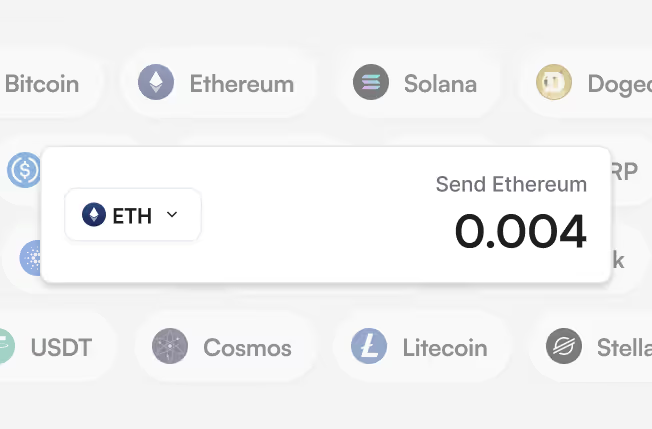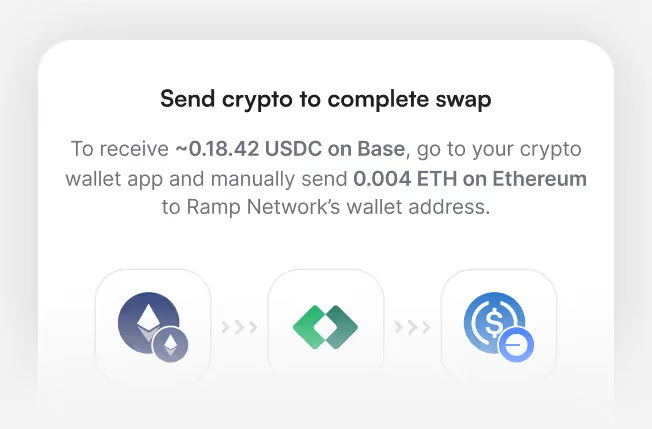


Swap USDC for Solana instantly.
Exchange USD Coin (USDC) for Solana (SOL) quickly and securely – no complex bridges or decentralized exchanges required.


.svg)










Exchange USD Coin (USDC) for Solana (SOL) quickly and securely – no complex bridges or decentralized exchanges required.


.svg)







Swapping USD Coin (USDC) for Solana (SOL) with Ramp Network is simple and secure. The process is built to be clear, fast, and user-friendly from start to finish.

1
Choose USD Coin (USDC) and Solana (SOL), enter the amount you’d like to swap, and review the live exchange rate before proceeding.

2
Sign up with your preferred method and confirm your country of residence to continue.

3
Ramp Network supports both self-custodial wallets such as Ledger or MetaMask and custodial exchange accounts. You remain in full control throughout the process.

4
Transfer the USDC from your wallet. Once the transaction is confirmed on the network, SOL is sent directly to your selected wallet or exchange account.

Ramp Network supports both self-custodial wallets such as MetaMask or Ledger and custodial exchange accounts. When swapping USDC for SOL, simply connect your wallet, review the details, and confirm the exchange.






The process is built to stay clear and intuitive. Ramp Network avoids complicated blockchain terms, making USDC-to-SOL swaps straightforward even for new users.
You remain in full control at all times. USDC is sent directly from your wallet, and SOL is delivered to the destination wallet or exchange account you specify. Ramp Network does not hold user funds.
Ramp Network operates across major regions, including the UK, EU, and US. Supported networks and currencies are shown clearly during checkout.

Before finalizing your swap, you’ll see a full overview of the transaction, including exchange rate and all associated costs, so you know exactly what you’ll receive.
*When compared to transferring via an exchange

USD Coin, often shortened to USDC, was launched in 2018 by Circle and Coinbase as a stablecoin pegged to the U.S. dollar. Each token represents one dollar held in cash or short-term U.S. Treasuries, making it a digital currency designed for stability rather than speculation.
What makes USDC stand out is how it bridges traditional finance with the crypto economy. It’s used daily by businesses, developers, and individuals to move value across borders without waiting for bank hours or paying wire fees. Whether you’re sending money to a friend, settling an invoice, or participating in DeFi protocols, USDC acts as a reliable digital version of cash.
The token is available on multiple blockchains, including Ethereum, Solana, Avalanche, and Polygon. That multi-chain support makes transfers faster and cheaper, and it helps USDC remain one of the most widely accepted stablecoins in the world. It’s not meant to make profits; it’s meant to make payments and settlements straightforward, transparent, and global.
Bitcoin (BTC) is the world’s first cryptocurrency, launched in 2009 by the mysterious creator known as Satoshi Nakamoto. Built on blockchain technology, Bitcoin introduced a new way of transferring value online without the need for banks or intermediaries. Its decentralized nature, combined with a fixed supply of 21 million coins, makes it a unique digital asset often referred to as “digital gold.”
Today, Bitcoin is the most recognized and widely used cryptocurrency worldwide. Millions of people use it for trading, investing, and cross-border payments, while businesses across industries accept Bitcoin payments as a secure and transparent alternative to traditional money. Its popularity continues to grow, supported by increasing adoption from financial institutions, mainstream investors, and even governments exploring Bitcoin regulation.
What makes Bitcoin special is its combination of scarcity, security, and decentralization. Unlike fiat currencies that can be printed endlessly, Bitcoin’s supply is limited, creating long-term value potential. Its blockchain is maintained by thousands of nodes across the globe, ensuring transactions remain transparent and resistant to censorship. For many users, Bitcoin represents more than just an investment — it’s a revolutionary step toward financial freedom and the future of money.
The chart displays an indicative, mid-market exchange rate. Effective exchange rate might be different.

Solana is a high-performance blockchain launched in 2020 by engineer Anatoly Yakovenko, who set out to solve one of crypto’s oldest problems – speed. By introducing Proof of History, a built-in clock that orders transactions automatically, Solana achieved block times measured in seconds and fees that cost less than a cent.
The network’s efficiency has made it a favorite among developers building NFT platforms, DeFi apps, and on-chain games where real-time interaction matters. SOL, the native token, powers it all, it’s used for staking, transaction fees, and network governance.
Solana has faced its share of challenges over the years, but its community and engineering team have continued to refine the infrastructure, improving stability and throughput with each upgrade. For many users, it represents a version of crypto that feels modern – fast, accessible, and ready for mainstream use.
Bitcoin (BTC) is the world’s first cryptocurrency, launched in 2009 by the mysterious creator known as Satoshi Nakamoto. Built on blockchain technology, Bitcoin introduced a new way of transferring value online without the need for banks or intermediaries. Its decentralized nature, combined with a fixed supply of 21 million coins, makes it a unique digital asset often referred to as “digital gold.”
Today, Bitcoin is the most recognized and widely used cryptocurrency worldwide. Millions of people use it for trading, investing, and cross-border payments, while businesses across industries accept Bitcoin payments as a secure and transparent alternative to traditional money. Its popularity continues to grow, supported by increasing adoption from financial institutions, mainstream investors, and even governments exploring Bitcoin regulation.
What makes Bitcoin special is its combination of scarcity, security, and decentralization. Unlike fiat currencies that can be printed endlessly, Bitcoin’s supply is limited, creating long-term value potential. Its blockchain is maintained by thousands of nodes across the globe, ensuring transactions remain transparent and resistant to censorship. For many users, Bitcoin represents more than just an investment — it’s a revolutionary step toward financial freedom and the future of money.
The chart displays an indicative, mid-market exchange rate. Effective exchange rate might be different.
Customers like you have traded over $1 billion in crypto with Ramp Network.